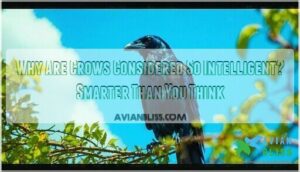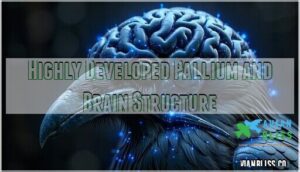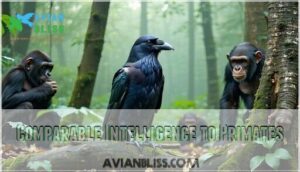This site is supported by our readers. We may earn a commission, at no cost to you, if you purchase through links.
 You’re witnessing nature’s feathered Einstein in action when you watch crows problem-solve.
You’re witnessing nature’s feathered Einstein in action when you watch crows problem-solve.
These corvids possess brain-to-body ratios rivaling primates, with densely packed neurons in their pallium – the avian equivalent of our cerebral cortex.
They craft tools from twigs, recognize individual human faces years later, and teach their offspring which humans to avoid.
Crows demonstrate abstract reasoning that scientists compare to seven-year-old children, planning multi-step solutions and even understanding cause-and-effect relationships.
Their social intelligence extends to complex communication networks where they share information about threats across entire populations.
What makes these remarkable birds truly exceptional goes far beyond their obvious cleverness, with capabilities that showcase their advanced cognitive abilities, making them a fascinating subject of study.
Table Of Contents
- Key Takeaways
- Why Are Crows Considered So Intelligent?
- Remarkable Problem-Solving Abilities
- Exceptional Memory and Learning
- Advanced Tool Use and Manipulation
- Highly Developed Pallium and Brain Structure
- Comparable Intelligence to Primates
- Social Intelligence and Cooperation
- Innovative Food Acquisition Techniques
- Potential Consciousness and Self-Awareness
- Implications for Animal Cognition and Evolution
- Potential for Understanding Intelligent Life on Other Worlds
- Frequently Asked Questions (FAQs)
- What is the #1 smartest bird?
- Do crows get attached to humans?
- Why are crows so intelligent?
- How are crows so smart with such small brains?
- Who is smarter, a crow or a dog?
- Are crows as smart as 7 year old humans?
- Are crows smart?
- Are crows intelligent animals?
- Do crows have social intelligence?
- What is Crow intelligence?
- Conclusion
Key Takeaways
- You’ll witness problem-solving that rivals primates – Crows craft tools from wire and twigs, plan multi-step solutions, and understand cause-and-effect relationships with the cognitive abilities of a 7-year-old child.
- They’ve got elephant-like memories for faces and grudges – You can’t fool a crow twice; they’ll remember your face for years and teach their offspring which humans to avoid or trust.
- Their brains pack more punch per ounce than most mammals – Despite having walnut-sized brains, crows squeeze 1.2-2.2 billion neurons into their forebrains through incredibly dense neural networks.
- You’re watching nature’s ultimate social networkers in action – Crows share threat information across entire populations, coordinate complex group hunts, and maintain sophisticated communication systems with over 250 distinct calls.
Why Are Crows Considered So Intelligent?
You’ve likely seen crows outsmart other birds, but their crow brain reveals remarkable intelligent behavior that rivals primates.
These corvids demonstrate problem solving abilities through innovative thinking and cognitive flex, using tools and recognizing faces with precision.
Crow intelligence represents advanced animal cognition, with corvid intelligence showcasing complex reasoning that challenges traditional views of intelligent birds and corvid cognition research.
Remarkable Problem-Solving Abilities
You’ll witness problem-solving abilities that rival those of great apes when you observe crows in action.
These remarkable birds demonstrate advanced cognitive skills through tool manipulation, strategic planning, and innovative approaches to complex challenges that would stump many other animal species, showcasing their cognitive skills.
Tool Use and Understanding Displacement
You’ll witness crows demonstrating tool crafting mastery through water experiments that showcase displacement concepts.
New Caledonian crows bend wire into hooks, achieving 80% success rates in object manipulation tasks.
Their cognitive flexibility allows rapid adaptation—dropping stones into tubes to raise water levels and access floating treats.
This innovative thinking reveals genuine problem solving abilities, with cognitive abilities matching 5-7 year-old children in displacement understanding.
The study of crow intelligence is often explored in crow intelligence books that examine their complex behaviors.
Planning Multi-step Processes
Crows don’t just solve single problems—they orchestrate complex, multi-step sequences that would challenge many mammals.
These corvids create cognitive maps, mentally rehearsing entire problem-solving chains before acting.
Sequential learning allows them to remember which tool works for each task, demonstrating future planning that rivals primates.
Their innovative thinking shines when they craft specialized tools, then execute multistep anticipation strategies, which transforms simple situations into sophisticated challenges requiring advanced problem-solving skills.
Keeping Tools for Future Use
Beyond multi-step planning lies an even more impressive feat: tool storage and future planning. New Caledonian crows don’t just craft tools—they keep them for later use, demonstrating remarkable long-term strategy and cache management.
This resource allocation behavior showcases cognitive abilities that rival those of young children, revealing sophisticated memory systems and innovative behaviors.
Consider these extraordinary tool use examples:
- Crows fashion wire hooks and store them in tree crevices for weeks
- They remember exact locations of cached tools for months
- Some individuals carry favorite tools during daily foraging trips
- Crows sharpen stick tools and preserve them between hunting sessions
- They select specific tools for different tasks, showing problem-solving foresight.
This behavior indicates crows understand future needs and plan accordingly—a cognitive leap that separates intelligent species from instinct-driven animals.
Exceptional Memory and Learning
You’ll be amazed by how crows remember individual human faces with startling accuracy, recognizing people years after their first encounter.
They don’t keep this information to themselves—crows actively communicate about specific humans to other crows and even pass these memories down to their offspring through generations.
Recognizing Individual Human Faces
American crows can pick out individual human faces from a crowd and remember them for over two years.
These feathered geniuses can spot your face in a crowd and remember it for years.
Their facial recognition abilities rival security cameras, with brain scans showing activation in memory regions when viewing familiar faces.
These corvids demonstrate remarkable human face recognition by categorizing people as threats or allies based on past interactions.
Studies reveal crows maintain facial recall accuracy of 67% after three years without re-exposure.
This social intelligence enables individual identification essential for survival, as memory skills help distinguish between dangerous hunters and friendly feeders.
Communicating About Humans to Other Crows
These intelligent birds possess remarkable social cognition that extends beyond individual recognition.
When you observe crows in the wild, you’ll notice their sophisticated Crow Vocalizations serve as complex Warning Calls to alert nearby birds about specific humans.
Research demonstrates that crow intelligence includes transmitting detailed information about threats through Social Learning mechanisms.
Intelligent birds like crows utilize communication patterns to share Human Face Recognition data across their community networks.
The ability to understand bird communication methods is essential in deciphering the complexity of crow interactions.
Here are three key aspects of their social intelligence:
- Alarm call specificity – Crows adjust vocalizations based on threat level and human behavior patterns
- Information cascading – Single encounters with dangerous humans spread rapidly through entire crow populations
- Contextual communication – Calls vary depending on audience composition and environmental factors
Passing on Grudges to Offspring
Hereditary behavior in corvids reveals how grudge inheritance shapes family dynamics across generations.
When parent crows identify threatening humans, they don’t just remember—they actively teach their offspring through social learning.
This intergenerational memory creates lasting crow culture patterns:
- Parents demonstrate alarm calls and aggressive postures toward specific individuals
- Juveniles learn to recognize facial features through repeated exposure and modeling
- Collective memory spreads through extended family networks, creating inherited animosity
This intergenerational grudge transmission transforms individual experiences into learned social behavior, ensuring survival knowledge passes down through corvid lineages.
Advanced Tool Use and Manipulation
You’ll witness remarkable ingenuity when you observe crows crafting sophisticated tools from everyday materials like twigs and wire.
These corvids demonstrate exceptional dexterity by bending metal wire into hooks, selecting specific objects based on buoyancy principles, and fashioning sticks into spears for precise food retrieval, showcasing their dexterity.
Using Sticks as Spears and Hooks
Crows demonstrate remarkable stick tooling abilities through their sophisticated spear making and hook crafting techniques.
These intelligent birds manipulate twigs with precision, creating specialized implements for extracting insects from bark crevices and tree holes.
Their adaptive behavior extends beyond simple twig shaping to strategic branch bending, allowing them to access previously unreachable food sources.
This advanced tool use showcases crow intelligence at its finest, with each bird customizing implements based on specific foraging challenges they encounter in their environment.
The complexity of their tools is reminiscent of professional stick tool sets used in various industries.
Bending Wire to Make Tools
Beyond natural materials, these corvids demonstrate remarkable wire manipulation abilities that showcase advanced tool crafting skills.
In controlled experiments, crows spontaneously bend straight wire into functional hooks without prior training.
This metal bending behavior involves three key techniques:
- Creating precise hook angles for efficient food retrieval
- Adjusting wire curvature based on container depth requirements
- Real-time modifications when initial tool design proves ineffective
This sophisticated wire shaping and hook making represents extraordinary problem-solving capabilities, with success rates reaching 90% in laboratory settings.
Selecting Objects That Will Float and Fit in Containers
When faced with Buoyancy Tests, crows demonstrate remarkable Object Selection skills that rival trained scientists.
These corvids understand Floatation Methods and Container Fitting principles, choosing items that displace water effectively.
Their Water Displacement mastery showcases advanced problem solving and tool use, revealing cognitive abilities that challenge our understanding of avian intelligence and memory.
The cognitive abilities of crows can be compared to the complex considerations involved in nest box placement strategies that attract specific bird species.
Highly Developed Pallium and Brain Structure
You’ll discover that crow intelligence stems from their highly developed pallium, which functions as the avian equivalent of your cerebral cortex.
Their brains pack neurons more densely than mammals, creating efficient neural networks that enable complex problem-solving and abstract thinking.
Pallium Equivalent to The Cerebral Cortex in Humans
You’ll find the pallium acts as the bird brain’s command center, functioning much like your cerebral cortex handles complex cognitive processes.
This brain structure drives neural connections that support advanced intelligence evolution through sophisticated neural mechanisms.
Key pallium features include:
- Dense neural networks – Packed neurons create efficient cognitive processing pathways
- Multi-layered organization – Structured regions handle specific avian neuroscience functions
- Cross-hemispheric communication – Left and right brain coordination enhances problem-solving
- Adaptive plasticity – Neural pathways rewire based on environmental learning experiences
Smaller but More Tightly Packed Neurons
Think of crow brains as nature’s ultimate miniaturization project. While their brains measure just walnut-sized, they pack roughly 1.2 to 2.2 billion neurons into their forebrains—matching some primates.
This extraordinary neural density creates superior brain efficiency through compact cognitive architecture. Consider these advantages:
- Faster information processing speeds
- Enhanced synaptic plasticity capabilities
- Reduced interneuronal distances for quicker responses
- Maximized cognitive complexity within limited cell structure
This neural efficiency explains their remarkable cognitive abilities despite smaller brain volumes, which is a result of compact cognitive architecture.
Efficient Communication Between Neurons
Their densely packed neurons create superior neural networking, enabling rapid synapse efficiency throughout crow brain anatomy.
Brain signals travel faster between cells, boosting cellular communication and cognitive abilities.
This neural efficiency supports remarkable neuroplasticity, allowing crows to adapt and learn complex behaviors.
Cognitive neuroscience reveals this enhanced cognitive complexity rivals primate intelligence systems.
Understanding bird neurological factors can provide insights into the neural basis of intelligence in various species.
Comparable Intelligence to Primates
You’d be surprised to learn that crow brains rival some primates in size and complexity, despite their vastly different evolutionary paths.
These remarkable birds can grasp abstract concepts without any training, demonstrating cognitive abilities that challenge our traditional understanding of animal intelligence across species boundaries.
Brain Size Comparable to Some Primate Species
When comparing brain size across species, corvids pack remarkable neural density into compact skulls.
Their brain structure demonstrates sophisticated cerebral development that rivals primate cognitive abilities.
This efficient neural architecture enables extraordinary cognitive flexibility, allowing crows to process complex information rapidly.
Animal cognition research reveals these birds achieve impressive intelligence scores despite smaller overall brain volumes.
The intelligence quotient measurements suggest corvids optimize neural efficiency rather than relying solely on mass, challenging traditional assumptions about brain-behavior relationships.
Ability to Grasp Abstract Concepts Without Training
Beyond impressive brain size, crows demonstrate remarkable Abstract Reasoning through spontaneous Concept Learning.
These Intelligent Insights emerge without explicit training, showcasing extraordinary Cognitive Flexibility.
Consider these abilities:
- Causal understanding – Crows grasp cause-effect relationships in novel situations
- Relational matching – They categorize objects as "same" or "different" instinctively
- Numerical discrimination – Mental Representation of quantities rivals primate capabilities
Their abstract thinking and problem solving abilities represent true cognitive convergence with intelligent species, challenging traditional views of avian cognition.
Difficulty in Measuring Intelligence Across Species
Measuring intelligence across species presents a complex challenge for researchers.
You can’t simply give a crow the same test you’d give a chimpanzee and expect meaningful results.
Different species evolved unique cognitive adaptations for their specific environments.
| Cognitive Metrics | Crows | Primates |
|---|---|---|
| Tool Use Complexity | Advanced hook-bending, multi-step sequences | Stone tools, termite fishing |
| Social Problem-Solving | Cooperative hunting, information sharing | Group coordination, alliances |
| Memory Tasks | Face recognition, cache locations | Spatial navigation, social hierarchies |
| Abstract Reasoning | Water displacement, cause-effect chains | Numerical concepts, symbolic thinking |
Cross Species Tests often fail because they’re designed with human or primate cognition in mind.
The Encephalization Quotient—brain size relative to body mass—doesn’t capture neural efficiency differences.
Crows pack neurons more densely than mammals, creating powerful processing in smaller brains.
Intelligence Scales must account for ecological pressures.
Comparative Intelligence research now focuses on Cognitive Convergence—how different species independently evolved similar problem-solving abilities.
This Interspecies Intelligence Comparison reveals that intelligence isn’t a ladder but a diverse landscape of specialized abilities.
Social Intelligence and Cooperation
You’ve probably noticed crows watching you and wondered if they’re actually thinking about you—and the answer is yes.
These remarkable birds possess sophisticated social intelligence that allows them to remember individual humans, communicate threats to their entire family, and coordinate complex group activities that would impress even the most organized human team.
They are able to remember individual humans, and also communicate threats to their entire family.
Remembering People Who Have Wronged Them
You’ve crossed a crow, and it remembers your face forever.
These corvids possess extraordinary Face Recognition abilities, storing detailed human facial data for years through advanced Memory Retention.
Their Grudge Holding capability creates lasting consequences:
- Inherited animosity passes recognition patterns to offspring genetically
- Intergenerational grudge transmission teaches young crows specific threat identification
- Crow Vigilance networks share grudges through complex social communication systems
This sophisticated Human Interaction memory system enhances survival and demonstrates remarkable problem solving intelligence.
Avoiding Areas Where They Have Been Hunted
You’ll find crows don’t just remember dangerous encounters—they actively avoid returning to areas where they’ve faced hunting pressure.
This hunting avoidance behavior demonstrates sophisticated danger awareness and survival tactics.
Their intelligence enables precise habitat selection for predator evasion.
Through memory and problem solving, crows map hazardous zones, ensuring their avoidance strategies protect the entire flock from future threats.
Crows exhibit advanced bird problem solving abilities, allowing them to adapt and thrive in various environments.
Working Together to Solve Problems
Crows demonstrate remarkable cooperative behaviors when tackling complex challenges together.
These social intelligence superstars use teamwork strategies that would impress any problem-solving expert. Their collective intelligence shines through coordinated efforts that maximize group success.
Here’s how crows master group problem solving:
- Cooperative hunting – Multiple crows coordinate to distract prey while others move in for capture
- Tool sharing – Group members pass specialized implements between individuals during complex tasks
- Social learning networks – Experienced crows teach problem-solving techniques to younger family members
- Strategic role assignment – Different crows take specific positions (lookouts, foragers, tool users) based on their strengths
Innovative Food Acquisition Techniques
You’ve probably watched crows effortlessly crack tough nuts by dropping them in front of moving cars, but their food acquisition strategies go far beyond this well-known behavior.
These remarkable birds demonstrate sophisticated planning, timing, and resource management that rivals some of the most intelligent species on Earth, showing remarkable abilities in their daily lives.
Dropping Nuts in Traffic to Crack Them Open
You’ve probably watched birds crack nuts with rocks, but urban crows have outsmarted that approach entirely.
These resourceful corvids drop walnuts and hard-shelled nuts directly into busy traffic lanes, transforming passing vehicles into efficient nut cracking tools.
This innovative behavior demonstrates remarkable problem-solving abilities and urban adaptation. Crows carefully select ideal drop heights and timing, showcasing their understanding of physics and traffic patterns in urban environments.
The study of crow behavior is often explored in crow intelligence books, which provide valuable insights into their problem-solving abilities.
Observing Traffic Lights to Retrieve Nuts Safely
Beyond simply dropping nuts onto roads, you’ll witness crows demonstrating remarkable traffic safety awareness.
These urban-adapted birds carefully observe traffic signals, waiting for red lights before retrieving their cracked nuts.
This sophisticated road crossing behavior showcases crow intelligence through strategic timing and risk assessment.
Their urban adaptation transforms city infrastructure into tool use opportunities, exemplifying advanced problem-solving abilities in modern environments.
Caching Food for Future Use
Strategic storage experts, crows excel at food caching—hiding snacks across territories for future retrieval.
These corvids demonstrate sophisticated foraging strategies, using memory and problem-solving skills to manage resources during scarce periods like winter.
- Cache Recovery Precision: Crows remember hundreds of hiding spots with remarkable accuracy, retrieving stored nuts and seeds months later
- Nut Management Tactics: They employ deception techniques, pretending to cache food while actually eating it to mislead potential thieves
- Seed Caching Distribution: Strategic placement across diverse locations guarantees backup food supplies remain accessible despite environmental changes
Potential Consciousness and Self-Awareness
You’ve likely wondered whether crows truly understand their own thoughts and mental processes.
Current research suggests these remarkable birds may possess self-awareness that enhances their problem-solving abilities, though scientists need more study to fully grasp the extent of crow consciousness.
Displaying an Understanding of Their Own Minds
Consider this remarkable fact: Three distinct cognitive abilities reveal how crows understand their own minds.
Research shows these corvids demonstrate Mind Awareness through Self Recognition in mirror tests, suggesting selfawareness.
Their Cognitive Insight emerges when they attribute Mental Models to competitors, indicating theory of mind and mindreading capabilities.
This Conscious Thought represents advanced cognitive abilities that enhance their intelligence through metacognitive self-monitoring.
Enhancing Problem-solving Abilities
When you understand consciousness, you’re seeing how crows approach problem-solving with remarkable cognitive flexibility. Their abstract thinking and foresight planning allow them to evaluate situations dynamically, combining past experiences with present conditions.
This adaptive learning creates innovative strategies that enhance their intelligence and adaptability through sophisticated tool use.
Here are five key ways consciousness enhances their cognitive abilities:
- Dynamic situation assessment – They evaluate multiple variables simultaneously before acting
- Experience integration – Past encounters inform present problem-solving approaches
- Flexible strategy switching – They abandon ineffective methods quickly for better alternatives
- Context-aware decision making – Environmental factors influence their chosen solutions
- Predictive problem solving – They anticipate obstacles and prepare contingency plans
Requiring Further Research to Fully Understand
How can you measure something as elusive as consciousness in crows? Scientists face fascinating challenges studying corvid cognitive abilities and animal cognition.
Current research methods can’t fully capture the complexity of Crow Brain Development and Intelligent Behavior patterns.
Three research priorities emerge:
- Advanced neuroimaging techniques to map Complex Sociality networks in corvid brains
- Longitudinal studies tracking Adaptive Learning across generations
- Cross-species comparisons examining Ecological Intelligence evolution
These investigations could revolutionize our understanding of avian intelligence and redefine intelligence itself.
Implications for Animal Cognition and Evolution
Crow intelligence forces scientists to rethink what’s currently understood about how brains evolve and function across different species.
Their cognitive abilities demonstrate that intelligence can emerge through entirely different evolutionary pathways than those seen in mammals, suggesting multiple routes to complex thinking in the animal kingdom.
Challenging Traditional Views of Intelligence
Crow intelligence dismantles long-held assumptions about animal cognition.
Scientists once viewed non-human minds through a narrow lens, expecting simple responses to environmental stimuli.
Corvids shatter these preconceptions with their cognitive flexibility and neural adaptation.
Their intelligent behavior demonstrates that avian intelligence operates through different neural pathways than mammalian brains, yet achieves comparable problem-solving abilities.
This challenges anthropocentric views of intelligence, revealing that complex cognition can emerge from diverse biological architectures.
| Traditional Assumption | Crow Reality |
|---|---|
| Instinct-driven behavior | Complex cognition and planning |
| Limited learning capacity | Adaptive learning across generations |
Their intelligent behavior is a showcase of complex cognition and adaptive learning, which are key aspects of their ability to thrive in various environments.
This unique blend of abilities makes them an interesting subject for studying animal cognition and intelligence.
Providing Insights Into The Evolution of Intelligence
Corvid intelligence illuminates the evolutionary pathways that shaped cognitive complexity across species.
You’re witnessing convergent evolution in action—corvids and primates developed similar problem-solving abilities independently, separated by 300 million years of evolutionary history.
- Evolution Mechanics: Corvids demonstrate that intelligence can emerge through different neural architectures when environmental pressures favor cognitive flexibility
- Brain Development: Extended juvenile periods in corvids mirror primate developmental patterns, allowing cumulative learning of complex behaviors
- Intelligent Behavior: Behavioral plasticity correlates with enlarged brain regions responsible for learning and memory in corvids
- Adaptive Traits: Social complexity and foraging challenges drove similar cognitive evolution in distantly related species
- Cognitive Complexity: Corvids achieve primate-like reasoning through dense neural networks rather than large brain size
This convergent evolution reveals that multiple biological pathways can produce sophisticated cognitive abilities when survival demands adaptive problem-solving skills.
Shaping Intelligence Based on Ecological Niches and Environmental Pressures
Environmental pressures act like sculptors, chiseling cognitive abilities from raw neural potential.
You’ll find that corvids developed adaptive intelligence through ecological adaptation to diverse habitats. Brain development responds to survival demands—urban crows evolved traffic-light recognition, while forest crows perfected tool manipulation.
This evolutionary convergence demonstrates how environmental pressures shape intelligent behavior across species.
| Environment | Cognitive Challenge | Adaptive Response |
|---|---|---|
| Urban landscapes | Traffic navigation | Traffic light recognition |
| Forest canopies | Food extraction | Advanced tool crafting |
| Coastal regions | Shellfish access | Rock-dropping techniques |
| Agricultural areas | Human interaction | Face recognition systems |
| Winter climates | Food scarcity | Strategic caching behavior |
Cognitive evolution follows ecological demands rather than random development patterns.
Potential for Understanding Intelligent Life on Other Worlds
Studying crow cognition opens windows to understanding extraterrestrial life possibilities. These corvids prove that human-like brain structures aren’t required for sophisticated animal cognition. Their pallium-based intelligence suggests alien intelligence could evolve through different neural pathways entirely.
Consider how crow research reshapes our cosmic awareness:
- Evolutionary convergence might produce similar problem-solving abilities across distant worlds
- Interstellar communication systems could mirror corvid vocal complexity and syntax patterns
- Galactic evolution may favor compact, efficient neural designs over large brain masses
- Cognitive abilities like tool use and memory could emerge independently in alien species
When you search for signs of intelligence beyond Earth, remember that crows demonstrate non-mammalian paths to consciousness. Their success challenges anthropocentric assumptions about what intelligent life should look like, expanding possibilities for discovery.
Frequently Asked Questions (FAQs)
What is the #1 smartest bird?
While crows are remarkably gifted intellectually, you’ll find the African Grey Parrot consistently ranks as nature’s most cognitively advanced avian species.
They demonstrate sophisticated reasoning abilities, complex vocabulary acquisition, and abstract conceptual understanding that surpasses even corvids’ impressive problem-solving skills, showcasing their remarkably advanced capabilities.
Do crows get attached to humans?
Yes, crows can form attachments to humans who consistently provide food or show kindness.
They’ll remember your face, sometimes bring small gifts, and may even defend you from perceived threats in their territory, which demonstrates a unique level of attachment.
Why are crows so intelligent?
Like nimble-fingered locksmiths, crows decipher nature’s puzzles with remarkable ease.
You’ll find they possess exceptional problem-solving abilities, advanced tool-making skills, and complex social intelligence that rivals great apes and young children in cognitive testing, showcasing their complex social intelligence.
How are crows so smart with such small brains?
You’re dealing with efficiency, not size.
Crow brains pack neurons densely—about twice as many per gram as mammalian brains.
Their brain-to-body ratio rivals great apes, maximizing processing power in compact space.
Who is smarter, a crow or a dog?
Comparing intelligence between crows and dogs isn’t straightforward since they excel in different cognitive areas. Crows demonstrate superior problem-solving abilities, creating tools and solving multi-step puzzles that rival great apes.
Are crows as smart as 7 year old humans?
Crows demonstrate cognitive abilities comparable to 7-year-old humans in specific tasks like understanding water displacement, solving multi-step puzzles, and using tools creatively, though they excel differently across various intelligence domains.
Are crows smart?
New Caledonian crows craft tools from twigs and wire, demonstrating cognitive abilities comparable to 5-7-year-old children.
You’ll find they solve multi-step puzzles, recognize faces, hold grudges across generations, and adapt innovative feeding strategies like using traffic to crack nuts.
Are crows intelligent animals?
Yes, crows are remarkably intelligent animals.
They possess cognitive abilities rivaling great apes and young children, demonstrating advanced problem-solving, tool creation, facial recognition, and complex communication systems.
With over 250 distinct calls, they exhibit complex communication systems that highlight their intelligence and social behavior.
Do crows have social intelligence?
You’ll find that crows excel at social intelligence through complex family structures, regional dialects, cooperative problem-solving, face recognition, and intergenerational knowledge transfer about threats and opportunities.
What is Crow intelligence?
Intelligence in corvids represents sophisticated cognitive processing you’d typically associate with primates.
You’ll observe their problem-solving abilities through multi-step tool creation, facial recognition lasting years, and strategic planning that rivals great apes in complexity.
Conclusion
Like the ancient Aesop’s fables where clever creatures outwit their adversaries, crows embody nature’s ultimate trickster archetype through their extraordinary cognitive abilities.
Understanding why crows are considered so intelligent reveals a remarkable convergence of advanced problem-solving skills, sophisticated social networks, and neural architecture rivaling primates.
Their tool-crafting abilities, facial recognition memory spanning years, and capacity for abstract reasoning demonstrate intelligence that challenges traditional boundaries between human and animal cognition, positioning these corvids as nature’s most compelling non-human intellects.
- https://www.ted.com/talks/joshua_klein_a_thought_experiment_on_the_intelligence_of_crows
- http://news.bbc.co.uk/2/hi/science/nature/4286965.stm
- https://www.popsci.com/science/article/2012-06/how-crows-recognize-individual-humans-warn-others-and-are-basically-smarter-you/
- https://www.smithsonianmag.com/air-space-magazine/crows-are-even-smarter-we-thought-180976970/

















